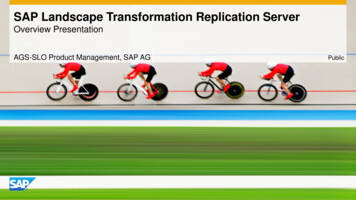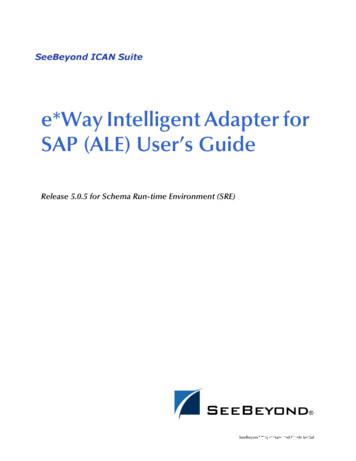Making SAP Information Steward A Key Part Of Your Data .
Making SAP Information Steward a Key Part of Your Data GovernanceStrategyPart 3 – SAP Information Steward Metadata Management and MetapediaPart 1 in our series on Data Governance defined the concept of Data Governance and gave suggestionson how to go about implementing an initial program at a corporate level. Part 2 provided an overviewof how SAP Information Steward can help you get started with a Data Governance program and detailedthe Data Insight module of the tool. In Part 3, we will now turn towards the Metadata Management andMetapedia modules of Information Steward to show how they can help in other areas of DataGovernance.Common ConcernsThe following questions and comments coming from within an organization are ones that we hear often: How were the values on this report calculated? Where is this data being sourced from? I can’t trust this report; some values look right but others seem way off base What definition of Customer do you mean here? We define it differently We view this set of materials as Finished Goods, but some other plants view them as semifinished. We sell these but that other plant is responsible for putting these materials into alarger assemblyMostly these conversations boil down to two main problems:1. Business users are completely blind to how the data they see in a report has been processed.They don’t know where it came from or how it was calculated, and therefore they don’t know ifit can be trusted2. Common terms are being lost in translation across the enterprise. One group defines a termone way, and the rest of the company defines it another. As a result, communication hasbecome challenging as conversations devolve into how to properly define certain terms, ratherthan solve the actual business problem that has come up.Metadata ManagementMetadata Management is the answer to the first problem. It is the Impact & Lineage Analysis toolavailable within SAP Information Steward that allows users the capability to trace the lineage of a pieceof data from report output back to source systems. Alternatively, one can also check the impact of anydata source on all downstream reports. In addition, it will identify all data objects in between those twoendpoints and determine if any transformations or calculations have occurred, giving your organizationa powerful lens into all of your data movements and manipulations.Metadata Management works by effectively “crawling” through your different source systems to gathermetadata objects from within them. The list of systems that can be connected is quite extensive andincludes SAP BusinessObjects Enterprise, SAP HANA, SAP ECC, SAP BW, SAP Data Services, mostcommon relational database management systems, and even the modeling tool SAP PowerDesigner. Itscapabilities can be taken even further if a license is obtained for the Meta Integration Model Bridge
(MIMB) tool, which allows for metadata integration of dozens of 3rd party tools. A full list of the toolssupported by MIMB can be found here. If all else fails, it is even possible to manually import metadatacontained in an Excel spreadsheet.Once connections have been created and metadata integrator tasks have been run on thoseconnections, SAP Information Steward displays the systems in the Metadata Management modulewithin the web application.Figure 1 Metadata Management Directory Home Page. Notice the different system typesNotice that Information Steward breaks down the connections by type, including Business Intelligence,Data Integration, and Data Insight Connections. Business Intelligence contains systems such as SAPBusinessObjects, SAP HANA, SAP ECC, and SAP BW. Data Integration includes any SAP Data Servicesrepositories that have been connected. And finally, the Data Insight Connections include any connectionthat has been used in the Enterprise Project of Data Insight. These are automatically added to MetadataManagement, allowing for even further analysis of those data sources.Lineage & ImpactThe real power of the Metadata Management module is its capability to perform impact and lineageanalysis. What this means is that as metadata integrators crawl through your different source systemsand gathers the metadata objects within, Information Steward automatically determines how thoseobjects relate to others within that system and also to objects in other source systems. This isincredibly powerful because the tool can then build visualizations to show relationships betweenmetadata objects and how data moves through your different systems. For example, the screenshot
below shows how an SAP BusinessObjects report is sourced from columns in an SAP HANA analyticalview.Figure 2 The Online Sales Report is sourced from many columns in the Internet Sales universe which ultimately sits on top ofan analytical view in a HANA databaseAlternatively, you can also view the impact that a data object has on other objects and other systems. Inthe screenshot below, the SALE HEADER table is used as a source for other tables in my SAP DataServices ETL environment, and this has a further downstream effect on the FACT INTERNET SALES tablein SAP HANA and the analytical views that are built on top of it.
Figure 3 Impact relationships of the SALE HEADER table as it moves through my Data Services ETL and into my HANAenvironmentYou can also change settings to tighten or loosen the logic that SAP Information Steward uses todetermine if two objects are related to each other. If changing the settings does not produce therelationship that is desired, there is also the option for users to create a user-defined relationshipbetween objects. This allows data stewards to manually input a relationship between objects to definethem as being equivalent or as one having an impact on the other. Finally, the impact and lineagerelationships of an object can also be displayed in a tabular format for an easy export out to an Exceldocument.
Figure 4 Tabular view of the impact diagram of the FACT INTERNET SALES table. The Export to Excel button is highlighted inthe upper rightMetapediaMetapedia is the answer to the second common problem from above. It is a corporate data dictionaryapplication with a built-in approval workflow that serves as a tool for data stewards to define commonbusiness terms and submit those terms for approval from higher-ups. Once approved, users can linkthose terms to other previously defined terms as well as to objects over in Metadata Management.With plenty of use, the population of terms will become a strong corporate resource that can be usedthroughout the enterprise. Furthermore, Metapedia terms that are linked to BusinessObjects reportscan be accessed directly through the SAP BusinessObjects InfoView portal when opening that report.And finally, Metapedia terms are exposed via a WSDL that allows web developers access to the termsand definitions through a web services call.Figure 5 The Metapedia home screen. Notice the Category hierarchy on the left and the Terms on the rightTerms are created through the All Terms area on the left side. They can then be added to one ormultiple categories, depending on what makes sense for that Term. It is important to note thatalthough Terms can be added to multiple Categories, a Category can only be added to one otherCategory.For those organizations that already have a data dictionary or wiki in place, it is possible to embed URLsdirectly into Metapedia terms. In fact, Metapedia definitions are formatted in HTML, so the text can beenriched beyond simple plain-text format. Let’s take the term “City” as an example:
Figure 6 Metapedia Term editor. Notice the embedded hyperlink, text color options, and other text formatting featuresTerms can be further enriched by adding synonyms and keywords. These enhance a Term by causingthis term to appear in search results if any of those synonyms or keywords are ever searched forthrough the Metapedia search function. The search functionality is also accessible through the WSDLmentioned earlier. As an example, if I search for “Locality”, City will now appear in my search results.Figure 7 City appears in my list of search results for "locality"
Figure 8 Terms that have been approved (green check mark) can be related to other terms and to metadata objectsFinally, notice also that Terms that have been approved have a green check mark to the left of them,and they are then able to be linked to other terms and metadata objects (Error! Reference source notfound.). Clicking on a related term or associated objects brings up that linked term (Figure 9) or object(Figure 10) directly.Figure 9 Linked term "Customer" accessed by clicking on the link through the Business Partner term
Figure 10 Associated object "BP: Partner 1" in the Business Partner term. Notice that clicking on the link took us over intothe Metadata Management area of Information StewardConclusionIn conclusion, Metadata Management and Metapedia can be powerful tools to use when building orexpanding your Data Governance program. Metadata Management gives business users visibility intohow data moves through the organizational landscape, which includes illustrating the source systemsthat the data in a report comes from. And Metapedia provides a corporate data dictionary for businessusers and web developers to use to determine the correct definition of terms that are used in yourorganization. Utilized together, they become a powerful application for giving business users the abilityto better determine where data comes from and how corporate definitions relate to the metadata thatthey care aboutIn future posts regarding Information Steward, I will highlight client-specific success stories that span avariety of industries. I’ll also show how these different modules can be used independently orcollectively to help you meet your data governance program goals.Rich Hauser, ManagerDecision First Technologies, A Protiviti Enterpriserichard.hauser@protiviti.comRich is a Manager in the Data & Analytics practice of Protiviti, specializing in Enterprise InformationManagement. He has delivered customized Data Governance and SAP BusinessObjects solutions forcustomers of all sizes across a variety of industries. With Protiviti, Rich utilizes SAP Data Services andSAP Information Steward.
Decision First Technologies, A Protiviti Enterprise richard.hauser@protiviti.com Rich is a Manager in the Data & Analytics practice of Protiviti, specializing in Enterprise Information Management. He has delivered customized Data Governance and SAP BusinessObjects solutions f
SAP Master Data Governance SAP Information Steward SAP HANA smart data integration SAP Data Hub SAP Cloud Platform Big Data Services SAP HANA, platform edition SAP Vora Customer Experience IoT Workforce Engagement SAP Cloud for Customer SAP Commerce SAP Marketing SAP Asset Intelligence Network SAP Predictive Maintenance and Service SAP .
SAP ERP SAP HANA SAP CRM SAP HANA SAP BW SAP HANA SAP Runs SAP Internal HANA adoption roadmap SAP HANA as side-by-side scenario SAP BW powered by SAP HANA SAP Business Suite powered by SAP HANA Simple Finance 1.0 2011 2013 2014 2015 Simple Finance 2.0 S/4 HANA SAP ERP sFin Add-On 2.0
SAP Certification Material www.SAPmaterials4u.com SAP Certification Material for SAP Aspirants at Low cost Home Home SAP Business Objects SAP BPC CPM SAP BPC 7.0 SAP EWM SAP GTS SAP Public Sector SAP Real Estate SAP FSCM SAP FI/CO SAP AC - FI/CO SAP BI 7.0 SAP CRM 5.0
SAP SAP Data HANA SAP BW/4HANA SAP MDG Services SAP Information Steward. Key SAP Products. Identity Management GRC and IAG Event Threat Detection AVM by . SAP . Greenlight. Central Finance SAP S/4HANA SAP BPC SAP IBP SAP Process Mining . WHERE WE EXCEL. Protiviti is a leader in finance transformation, analytics and risk management. As a long .
SAP Business Suite SAP BW SAP Apps Partner Apps SAP HANA PLATFORM Planning and Calculation Engine Real-Time Replication Services Information Composer & Modeling Studio SAP UI HTML5 Mobile SAP BI 4 SAP ERP SAP CRM SAP SCM SAP PLM SAP SRM SAP Netweaver Predictive Analytics & Business Function Libraries In-Memory
SAP HANA Appliance SAP HANA DB In-Memory A io BI Client non-ABAP (SAP supported DBs) SAP Business Suite SAP Business Suite SAP Business Suite SAP Business Suite SAP Business Suite SAP Business Suite SAP Business Warehouse SAP HANA DB r In-Memory Source Systems SAP LT Replication Ser
ALE/RFC Setup 88 SAP System Type 88 SAP IDoc Version 88 Program ID (SAP to e*Gate) 88 SAP Load Balancing Usage (e*Gate to SAP) 89 SAP Application Server (e*Gate to SAP) 89 SAP Router String (e*Gate to SAP) 90 SAP System Number (e*Gate to SAP) 90 SAP Gateway Ho
Customer Roadmap to SAP Simple Finance - Example " Adopting SAP Simple Finance is a journey - start early" Side-by-side SAP HANA Acceleration SAP HANA accelerators, BW, BPC, GRC SAP Business Suite on SAP HANA SAP ERP on SAP HANA SAP ERP in SAP HANA Enterprise Cloud SAP Accounting Powered By SAP HANA Simple Finance add-on/























